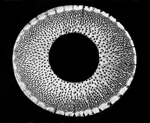|
1549 ... The Catholic Christian Century in Japan
& the Temple Patron Household System
INTRODUCTION
In the words of George Elison, 1973/1988:
"The “Christian Century" of Japan extends from 1549 to 1639, from the arrival of Saint Francis Xavier to the Tokugawa interdiction of all traffic with Catholic lands.
The century falls short of a hundred years, the religion failed in its evangelical aims.
Paradoxically, the significance of this entr'acte is not in the triumph of Christianity but in the effect of its defeat.
The Christian intrusion left few Christian traces; it was but the exotic element in an already gaudy period of Japanese history.
But upon the "Christian Century" follow more than two centuries of Sakoku, the Closed Country.
The Christian aberration would be a mere interlude were it not for its causal relation to the Sakoku policy.
The total rejection of Christianity helps to define an era.
Christianity was introduced into Japan at a time when that country's medieval order was in its final convulsions.
The missionaries viewed a tumbling body politic.
But beneath the surface of a country rent by war developed institutional changes which gave form to Japanese history's Early Modern period.
The broad terms which define this concept of comparative history for Europe apply as well to Japan: secularization of the tenor of life and rationalization of political authority.
In the Japanese interpretation, the ethos and the doctrine of Christianity clashed with these."
Quoted from George Elison: "Deus Destroyed. The Image of Christianity in Early Modern Japan." 1973/1988, p. 1.
As introduction and for inspiration, here you have George Elison's "Chronology" of the "Christian Century" in Japan, highlighted major events,
presented on pages ix to xi:
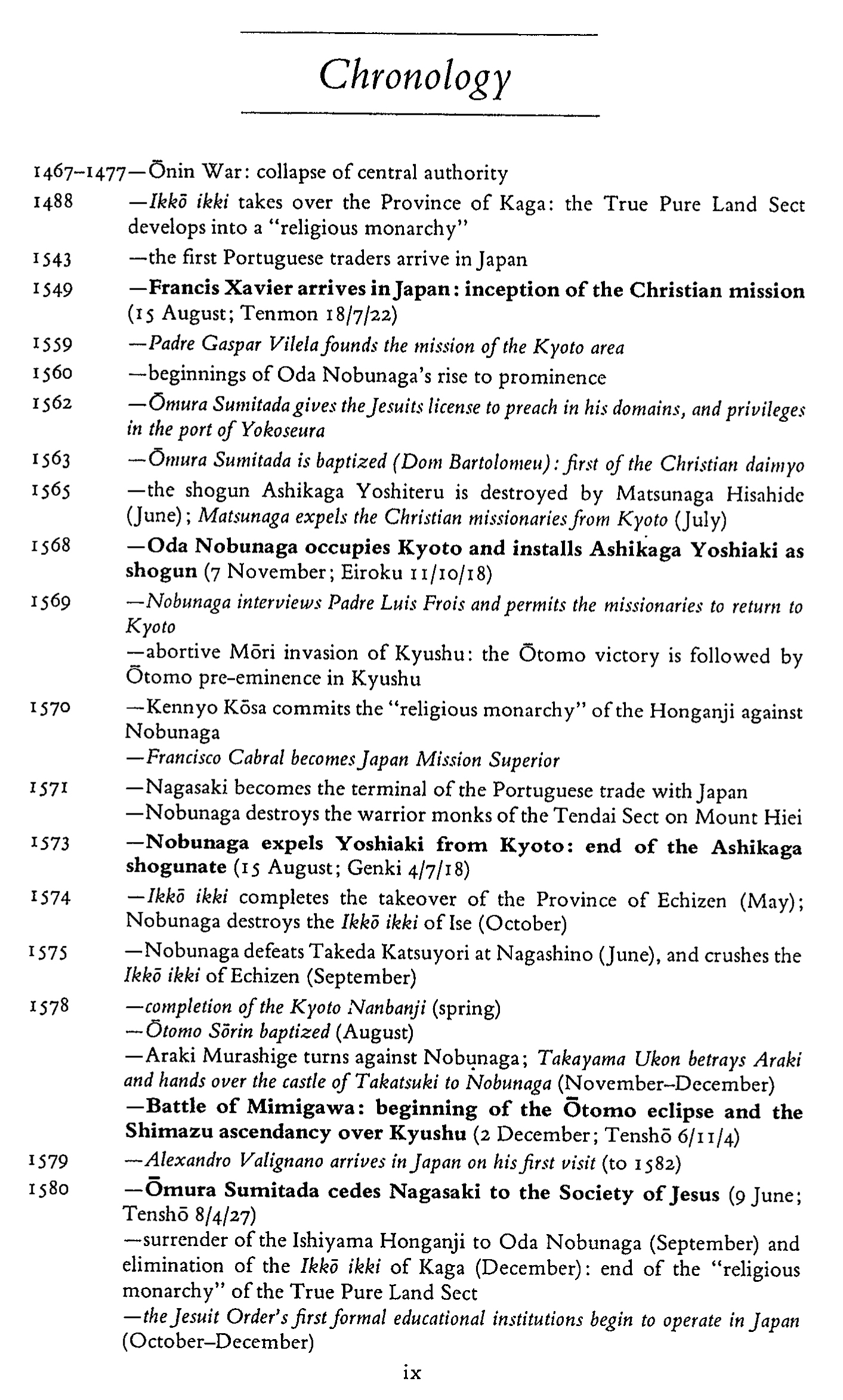
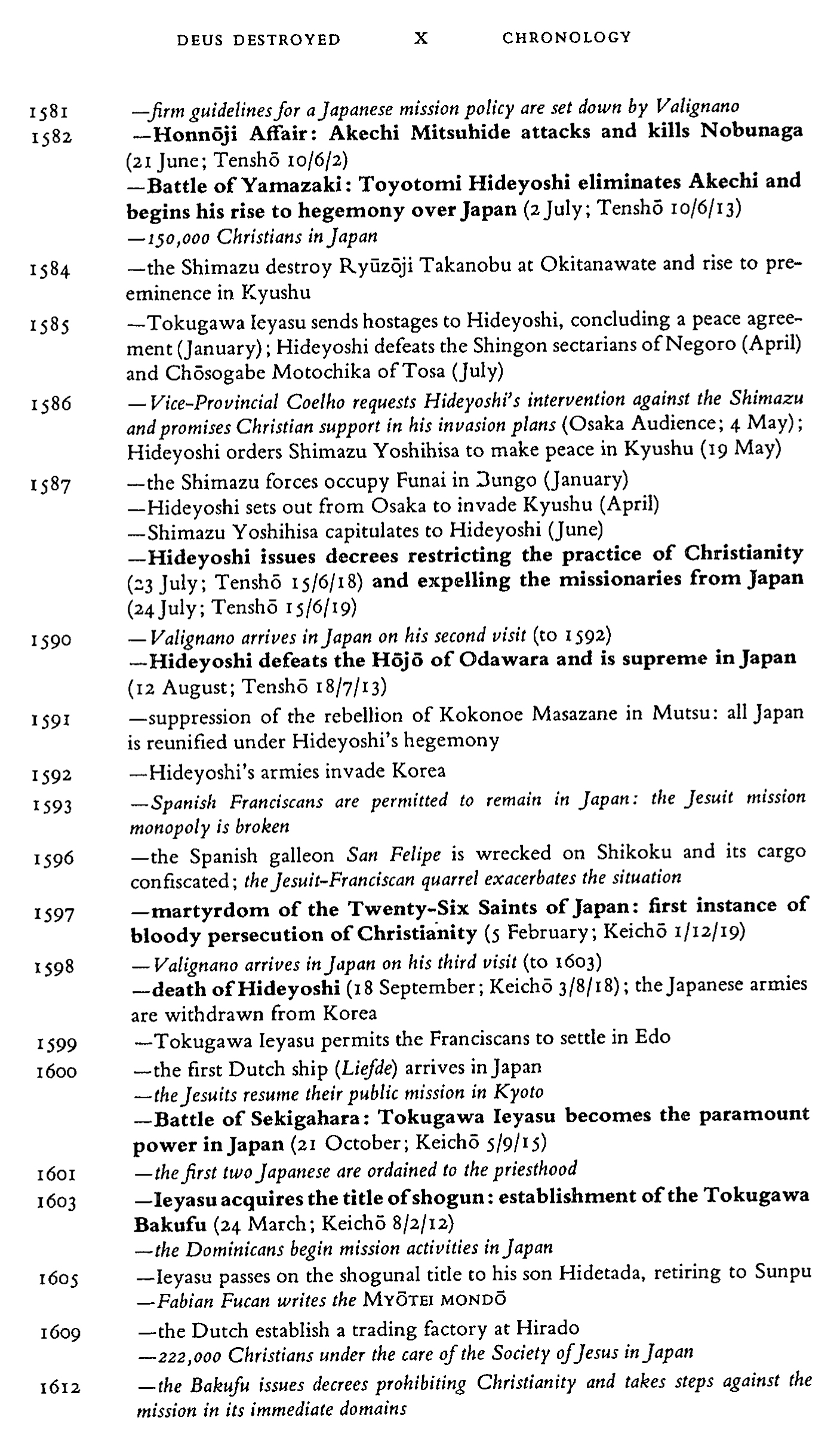
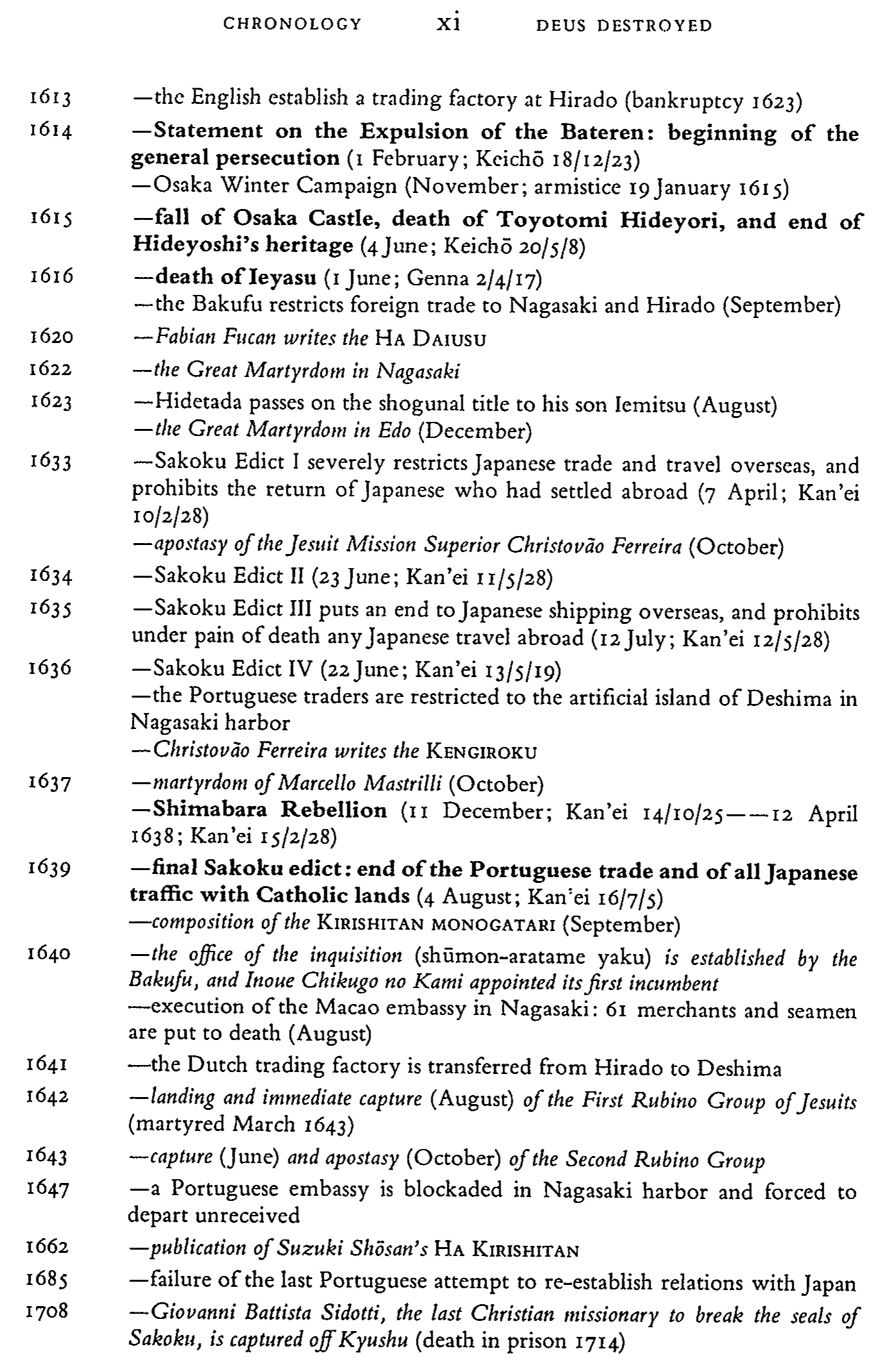
In the words of John Dougill, 2012:
"In 1549 the first Christian missionaries arrived in Japan.
Over the next sixty years the mission managed to convert more than 300.000 Japanese to their belief, including some of the most powerful people in the country.
But in the process they made enemies too, and in 1614 a nationwide ban was issued, followed by a vicious campaign of persecution.
A religion that preached against the workings of evil was itself denounced as evil.
Because it threatened the power of the shogun, torture and executions were increasingly used against Catholic believers as the authorities grew determined to make them recant.
Over 4.000 people are known to have died for their faith, and thousands of others suffered misery and ruination.
In 1639 the country was sealed to prevent "contagion" from the outside, and by the end of the next decade it seemed the religion had been eradicated from the country."
Quoted from the preface in John Dougill's "In Search of Japan's Hidden Christians.
A Story of Suppression, Secrecy and Survival." Tuttle Publishing, 2012.
In the words of Jonathan Clement, 2016:
"In 1638, the ruler of Japan ordered a crusade against his own subjects, a holocaust upon the men, women and children of a doomsday cult
in the remote south-western district of Shimabara.
Introduced a century earlier by foreign missionaries, the sect was said to harbour dark designs to overthrow the government.
Its teachers read and wrote a dead language, impenetrable to all but the innermost circle of believers.
The leaders preached love and kindness, but had helped local warlords acquire firearms.
They encouraged believers to cast aside their earthly allegiances and swear loyalty to a foreign god-emperor.
They urged their followers to seek paradise in terrible martyrdoms and, for many years, the Japanese government's torturers and excutioners had obliged them.
The hated cult was in open revolt, led, it was said, by a boy sorcerer.
Farmers claiming to have the blessing of an alien god had bested trained samurai in combat and proclaimed that fires in the sky would soon bring about the end of the world.
The Shōgun called old soldiers out of retirement for one last battle before peace could be declared in Japan.
For there to be an end to war, he said, the Christians would have to die."
Quoted from the introduction in Jonathan Clement's "Christ's Samurai. The True Story of the Shimabara Rebellion." Robinson, 2016.
In the words of Renata Cabral Bernabé, 2022, partly referring to Stephen Turnbull, 2013 (1998):
"In 1640, the “Office for the Inquisition of the Christian Sect” (Kirishitan shūmon
aratame yaku also known as kirishitan yashiki) was created.
This office created a centralized population surveillance regime and its terauke seido, a temple certification system.
In this system, all families were obligated to have a Buddhist temple declaration certifying that they were not kirishitan.
Initially, it was only aimed at the old kirishitan families, but after the Shimabara-Amakusa Rebellion, it was enforced throughout the entire population.
After the uprising, the bakufu began to see the "Christian threat" differently."
In the words of William P. Malm, 1959:
"The ranks of the komusō were not drawn primarily from the seekers of Buddha's paradise.
Rather, they were filled with ronin, masterless samurai who had lost their original rank and privileges during the violent clan struggles that marked the late sixteenth century.
These men sought satisfaction more in earthly revenge than in heavenly rewards.
It was from such ranks that many of the early Christians were drawn.
When the Christian movement was halted by the slaughter of Shimabara (1638),
many of these ronin felt their entire class would fall victim to the paranoid vengeance of the shogun government.
It is believed that one group of these desperate men formed a komuso group in Kyoto called the Fukeshu."
Quoted from William P. Malm, 1959, pp. 153-154.
RECOMMENDED READINGS - go to page bottom
宗門改役 - SHŪMON ARATAME-YAKU
檀家制度 - DANKA SEIDO
In 1640, in direct consequence of the Shimabara Rebellion at Shimabara, Kyūshū, SW Japan, the Tokugawa Bakufu/Shōgun Iemitsu,
ordered the socalled Shūmon aratame-yaku, or "officers for examining the religious sects", to be set up.
Iemitsu appointed Inoue Chikugo-no-Kami Masashige to the office grand inquistor.
From this time on, the major sects of Japanese Buddhism were made responsible for producing registers of religious affiliation of every Japanese household
with one specific Buddhist temple.
The socalled Danka seido,
檀家制度,
or "Danka System", i.e., more precisely : "Patron Household System", in which Japanese households since the Heian Period, 794-1185,
had voluntarily been supporting the temples financially, was now reshaped into a most effective instrument with which the government could monitor the population and -
first of all - suppress and eliminate the Christian faith and its believers, on a mandatory basis.
Read more about the Danka seido - and the very important socalled tera-uke seido
寺請制度, or "Temple Affiliation (Certification) System", and its
tera-uke shōmon
寺請証文, or "Temple Affiliation Certificates"
that had to be issued annually by the Buddhist temples and their inspecting monks - on this webpage for example:
Wikipedia: The Danka System
Even though the later 'Komusō' fraternity was, seemingly, to some extent officially recognized by the Tokugawa government on January 11, 1678,
in some capacity as a "semi-religious brotherhood", the 'Komusō' "temples" did not play any role
in administering and partaking professionally in the Danka Seido System of the Edo Period at all.
Furthermore, the 'Komusō' are not known to have performed formal funeral and ancestor commemoration services,
nor do the 'Komusō' temples appear to have had any cemeteries for the common population - nor for themselves, in fact! - within their precincts. *
This possibly explains, at least in part, why it did not require much more than a few brush strokes for the new Meiji Government - in October, 1871 -
to completely bring an end to the 'Komusō' tradition and all of that lay Buddhist brotherhood's activities.
* See f.i. Yamaguchi Masayoshi, 2005, p. 187.
See also this webpage:
To be - or not to be: a "Zen Buddhist Priest"?
Online sources of the below select chronology, links & literature:
Timeline of Japanese History,
History of the Catholic Church in Japan,
Christianity in Japan,
Martyrs of Japan, and
Wikipedia: The Danka System
- as well as books on Japanese history by Sansom, Reischaur, Fairbanks and many others - also see the bibliography at page bottom.
A Chronology of the Christian Century in Japan
- by Torsten Olafsson, Denmark:
1549, August 15: The Spanish Jesuit missionary Francis Xavier lands in Kagoshima and begins movement to spread Christian teaching in Japan.
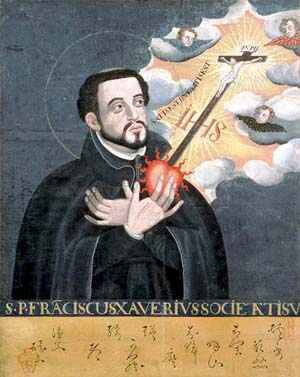
Japanese portrait of Francis Xavier (1506-1552)
Kōbe City Museum, Kōbe, Japan
1549, September 29: Xavier meets Shimazu Takahisa at Ijuin and receives permission to preach Christianity.
1550: Xavier translates the Catechism and the "Explanation of the Creed" into Japanese.
1553: The Japanese layman Bernard is admitted to the Jesuit novitiate in Portugal.
1556: Fr. G. Vilela and companions arrive in Japan at Funai {Oita].
1557: Brother Luis of Almeida opens the first hospital in Japan at Funai.
1559: Vilela and Brother Lorenzo open a church at Shijō in Kyōto.
1560: Oda Nobunaga begins to eliminate his daimyō enimies.
Vilela has an audience with shōgun Ashikaga Yoshiteru in Kyōto.
Yoshiteru issues orders that the missionaries are to be well treated and not taxed, and are authorized to work in Kyōto.
By this time there are about 12 missionaries in Japan, most living and working on Kyūshū.
1563: Friar Luis Frois arrives on a Portuguese ship in Nagasaki.
1565: Shōgun Ashikaga Yoshiteru, protector of the missionaries, is assassinated. The powerful daimyō Matsunaga Hisahide promulgates their banishment.
1566: The Emperor, under pressure from the Buddhists, issues an order expelling Christian missionaries from Kyōto. They flee to
Kyūshū and Sakai/Ōsaka.
1569: The first Christian church in Nagasaki is opened.
1569: After a meeting with Nobunaga and Yoshiaki in Kyōto, Jesuit missionaries are allowed back in the capital to preach.
1570: Christians in Japan are estimated to now number 20.000 to 30.000.
1574: Nobunaga defeats Ikkō sect followers and their supporters in a protracted seige of their strongholds at Nagashima.
He accomplishes this by by offering peace and then massacring 40,000 believers when they accept.
1575: Nobunaga defeats the Ikkō sect in Echizen and Kaga Provinces- and massacres another 40,000 believers.
1575: At the Battle of Nagashino, Nobunaga's troops are the first to use firearms: muskets, on a large scale - weaponry introduced in Japan by European merchants and missionaries.
1582: Nobunaga dies and his general Toyotomi Hideyoshi gains control. The are now about 200 Christian churches and around 150.000 Christian converts in Japan - predominantly in the south.
1582: A Japanese delegation is dispatched to visit the Pope in Rome.
1583: Toyotomi Hideyoshi commences the construction of the grand Castle of Ōsaka.
1584: A Spanish trading ship, blown off course in a storm, enters Hirado. Because he is jealous of Nagasaki's monopoly with Portuguese traders
and he dislikes the Jesuits, Matsuura, the daimyō there, welcomes it and agrees to receive other Spanish traders and non-Jesuit missionaries in Hirado
if they wish to come.
1584: Hideyoshi occupies Kyōto and enters an alliance with the powerful Tokugawa Ieyasu.
1585: Hideyoshi brings Shikoku under control and becomes Imperial regent, Kanpaku.
1587: Hideyoshi becomes Prime minister, Dajōdaijin of Japan and issues an edict forbidding Christianity and orders all missionaries to leave Japan.
1588: Hideyoshi takes direct control of Nagasaki and confiscates church property.
1588: Hideyoshi issues the "sword hunt" order to eliminate the otherwise potential risk of future peasant and warrior monk revolts.
Swords are confiscated from all non-samurai.
1590: Hideyoshi overpowers the Hōjō Clan in the Kantō region (present-day Tōkyō region) and is now in control of all of Japan.
1590: The Japanese delegation to Rome, dispatched in 1582, returns to Japan.
Late 1590: Hideyoshi orders the a national census to be taken. After they begin to appear in the census figures, Hideyoshi orders the expulsion of all rōnin
from towns and villages in which they did no farm work or military service.
1591: Hideyoshi issues a three-article law concerning social status: Warrior, farmer, artisan and merchant classes are firmly fixed.
Hideyoshi orders the renowned tea master Sen no Rikyū to commit suicide.
1592-1593: Toyotomi Hideyoshi sends troops to invade Korea with the ultimate goal of conquering the entire Eastasian mainland.
1593: Korean movable type printing equipment is brought back to Japan by Hideyoshi's troops.
1593: The Portuguese Franciscan Fr. Pedro Bautista arrives in Japan which soon causes serious conflicts with the Jesuits.
1596: The "San Felipe Incident". Read a dramatic online description of this fatal shipwreck event on a sandy beach in Tosa/Kōchi on SE Shikoku Island
that led to the eventual execution of 26 Catholic Christians in Nagasaki:
Kirishitan.com: February 5th: The Dictator Hideyoshi and the 26 Martyrs
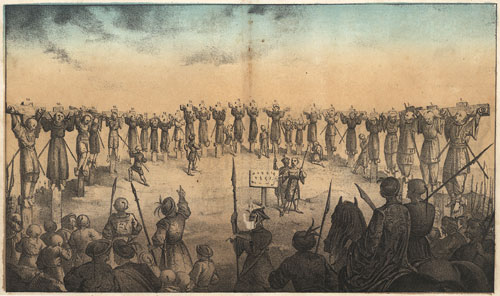
The 26 Christian Martyrs in Nagasaki. Painting by Eustaquio Maria de Nenclares, 1862.
Source: WikiPedia: The San Felipe Incident
1597: Hideyoshi sentences to death 26 Christians on a list of Kyōto Christians drawn up by Ishida Mitsunari.
On February 5, 1597, 26 Christians - missionaries and Japanese followers alike -
are crucified at Nishizaka in Nagasaki on the order of Toyotomi Hideyoshi, then the absolute ruler of Japan.
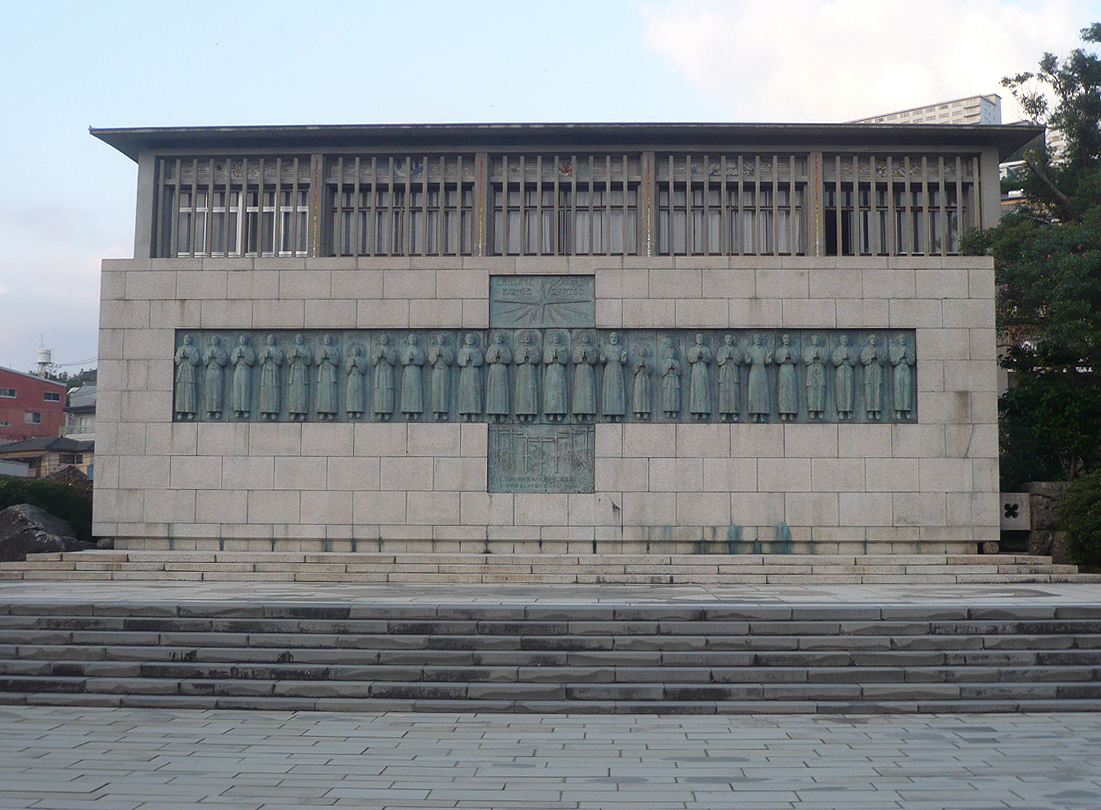
The 26 Christian Martyrs Memorial Monument, Nagasaki.
Source: WikiPedia
1597: Hideyoshi issues an order to expell all christians from the country. (He allows a few to remain to serve the small Portuguese community in Nagasaki.)
The vast majority of missionaries go into hiding and never leave. There are an estimated 300,000 converts in the country by this time.
1597-1598: Toyotomi Hideyoshi's second invasion of Korea, this time primarily as a retaliatory offensive against the Koreans.
1598: Hideyoshi dies. The remaining Japanese troops of the second Korea invasion are withdrawn.
1600: Tokugawa Ieyasu, Hideyoshi's trusted ally, having first put down a renewed rebellion of the daimyō clans,
defeats the Ishida Clan and its "Western allies" in the battle at Sekigahara, thus gaining control of the entire country.
1600: English pilot Will Adams lands in Japan in a shipwreck.
1602: Augustinians and Dominicans arrive in Japan.
1603: Ieyasu receives the title of Shōgun, Superior General, from Emperor Go-Yōzei and establishes his headquarters,
the Tokugawa Bakufu, in a new capital named Edo - present-day Tōkyō.
By this time an estimate of 87 daimyō families have been completely eradicated.
1607: The Neo-Confucian scholar Hayashi Razan, 1583-1657, is appointed political advisor
to the second shōgun Tokugawa Hidetada (in office 1605–1623).
Neo-Confucianism is now the official "state ideology" in Japan.
1612: Ieyasu outlaws the Christian faith in all territories under direct control of the Bakufu. Martyrdoms in Edo.
1613: All Christian churches in Kyōto and Nagasaki are destroyed and the clergy arrested.
Christians in Japan number about 220.000.
1614, January 27: Tokugawa Ieyasu issues an edict completely prohibiting Catholic Christianity in Japan.
Attached to the edict are 15 rules for the guidance of the Buddhist priesthood in securing its enforcement, for instance,
" --- everyone must become a member of one or another of the principal Buddhist sects, the head of the family being responsible for the choice thereof."
Source: C.R. Boxer, 1993, pp. 318-319.
Acc. to Wikipedia.org, "Between 1553 and 1620, eighty-six Daimyōs were officially baptized, and many more were sympathetic to the Christians."
Read more here: Wikipedia.org: Kirishitan
1614: November: All churches in Kyōto and Nagasaki are destroyed.
1615: The "Ordinances for the Military Houses", Buke shohatto, totalling 13 paragraphs, are promulgated.
1620: Fabian Fucan/Fukansai, c. 1565-1621, publishes the Ha Daiusu,
破提宇子, "Deus Destroyed", after his defection, a treatise against Christianity.
More information here:
Readings on early Christianity in Japan from the Keiō University Education Support System
WikiPedia: Fabian Fucan/Fukansai
1622: The "Great Genna Martyrdom" at Nagasaki.
55 arrested Christians die from torture, exhaustion or execution.
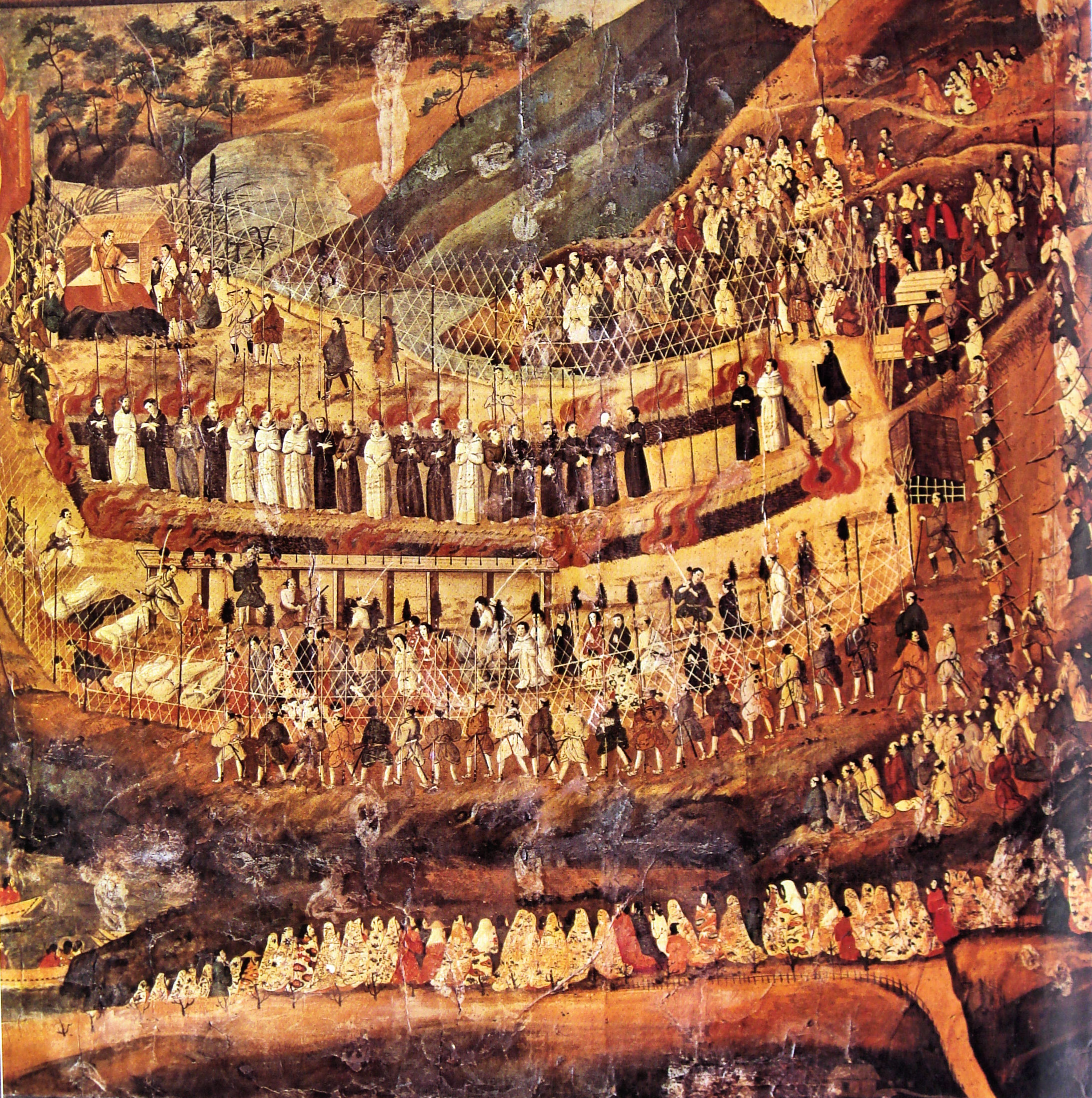
"The Great Genna Martyrdom in Nagasaki"
Painting by unnamed Japanese artist.
1623-1651: Tokugawa Iemitsu Shōgun,
徳川家光将軍,
is in supreme power,
decides to completely eradicate and exterminate Christianity, European Catholicism, in Japan.
Iemitsu definitely succeeds in that commitment of his!
1623: The "Great Martyrdom of Edo".
First 50, soon afterwards furthermore 37 Christians are executed.
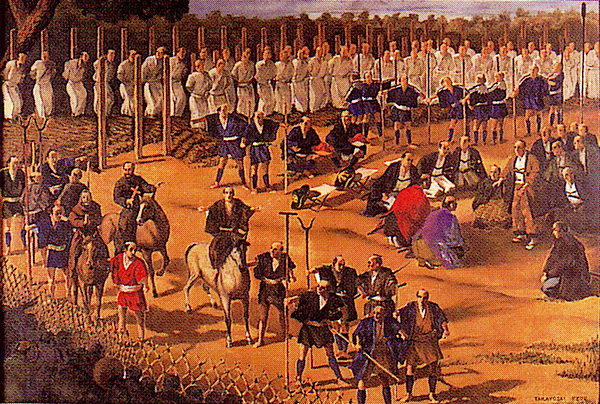
"The Great Martyrdom in Edo".
Painting by unnamed Japanese artist, no date.
In the words of Hubert S.J. Cieslik, 1954, p. 1:
"In the midst of the seething traffic of the metropolis, Tōkyō, on the
main road joining the capital with Yokohama, lies a plot of land that
is especially sacred to Tōkyō's Catholics.
In the Tamachi,
田町,
quarter not far from the Fuda-no-tsuji,
札ノ辻,
carstop, is a small Buddhist temple called Chifukuji,
智福寺.
It stands directly on the spot where more than 300 years ago, on December 4, 1623, 50 Christians suffered martyrdom by fire.
Among the martyrs were the leading missionaries and Christians of the Edo mission, so that the event practically spelled the
end for this once so flourishing mission.
The consequences, moreover, were reaching even farther.
As was intended by the government, it touched off another countrywide persecution and signalled the beginning of the systematic policy of extermination
under the third Tokugawa Shōgun, Iemitsu,
徳川家光,
(Shōgun 1623-1651)."
Source:
Hubert S.J. Cieslik: "The Great Martyrdom in Edo, 1623:
Its Causes, Course, Consequences."
In: Monumenta Nipponica X, 1954, pp. 1-44.
Link to PDF file: https://www.jstor.org/stable/2382790
1626: The Friars Pacheco, B. Torres and others are martyred in Nagasaki.
踏み絵 - FUMI-E
1629:
The practice of fumi-e, 踏み絵 - the forced trampling of Christian images -
is introduced and kept in constant national execution and effect through the year 1858.
The religious authorities of the Tokugawa shōgunate requires suspected Christians to step on images of Jesus Christ
or the Virgin Mary in order to prove that they are not members of that deeply hated and outlawed religious faith.
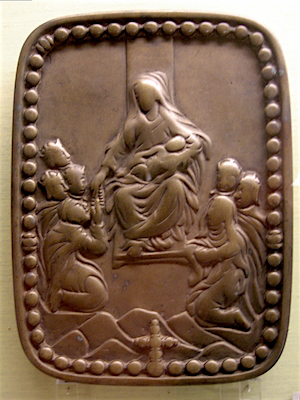
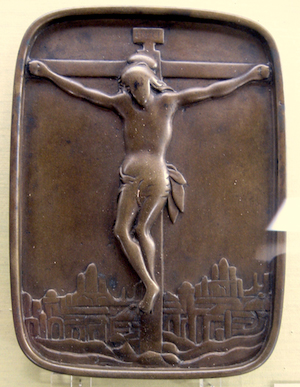
Fumi-e: The Virgin Maria & Jesus Christ
Source: https://russellstutler.com/russ/kirishitan.html
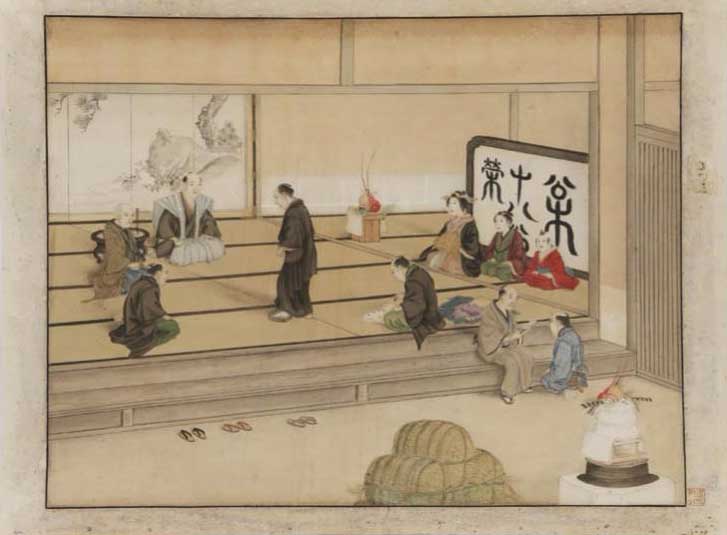
Painting of a 'fumi-e' inquisitional ceremony created by Keiga Kawahara, 1786–1860?, a citizen of Nagasaki,
created sometime during 1800-1829.
Source: National Library of the Netherlands.
1626-1633: The Nagasaki city magistrate Mizuno Kawachi-no-kami and his successor Terazawa Hirotake organize a "reign of terror" against Christian converts,
most of them peasants, in the districts under their control.
1635 - The Jisha bugyō, Magistrate of Temples and Shrines, is officially established as a permanent position.
Four Jisha bugyō, "temple & shrines magistrates", are appointed from among the fudai daimyō, and
since now they take turns in the position for one-month intervals.
島原の乱 - SHIMABARA no RAN
1637-38 - THE SHIMABARA REBELLION in KYŪSHŪ
1637: Christian farmers, warriors, rōnin (masterless samurai) and others revolt against the authorities on the Shimabara Peninsula in Kyūshū.
When the uprising was put down in 1638, tens of thousands had been killed. All surviving rebels, numbering in the thousands, were decapitated.
Christianity was now strictly outlawed in Japan and informers were encouraged.
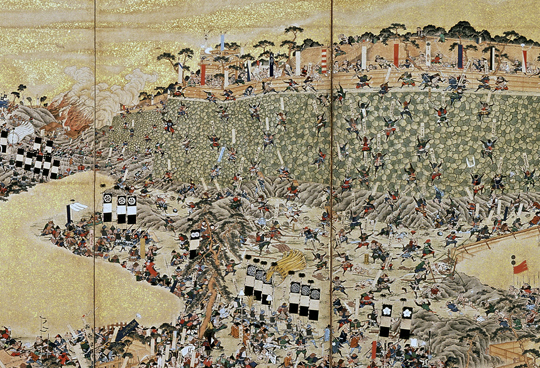
'Shimabara ran-zu byōbu'
"Folding screen depicting the rebellion at Shimabara".
Source: Wikipedia.
In the words of Masaharu Anesaki, 1938, p. 1:
"quotation"
Source:
Masaharu Anesaki: "Prosecutions of Kirishitans after the Shimabara Insurrection."
In: Monumenta Nipponica, Vol. 1, No. 2 (July, 1938), pp. 293-300 (8 pages)
Link to online PDF file:
https://www.jstor.org/stable/2382669?seq=1
In the words of George Elison, 1988 (1973), p. 195:
"The search for Christians within Japan was intensified and systematized after the Shimabara Uprising.
One major step of the Bakufu was to renew instructions to the daimyo for a strict winnowing of their populations.
Another was the establishment of an organ in Edo to coordinate the pursuit throughout Japan of the anti-Christian policy.
The office of the shūmon-aratame yaku (the name translates very well as Inquisitor) was instituted
in the sixth month of Kan'ei 17, the month of the Macao embassy's martyrdom.
Inoue Chikugo was the first incumbent.
The constituents of the final solution were now complete."
1630s ... :
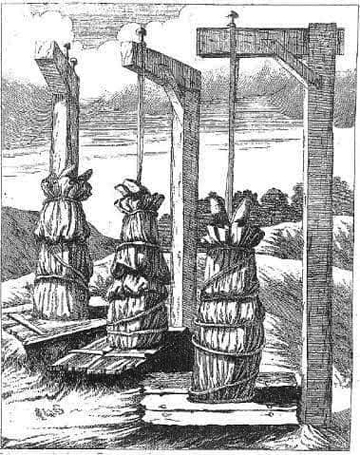
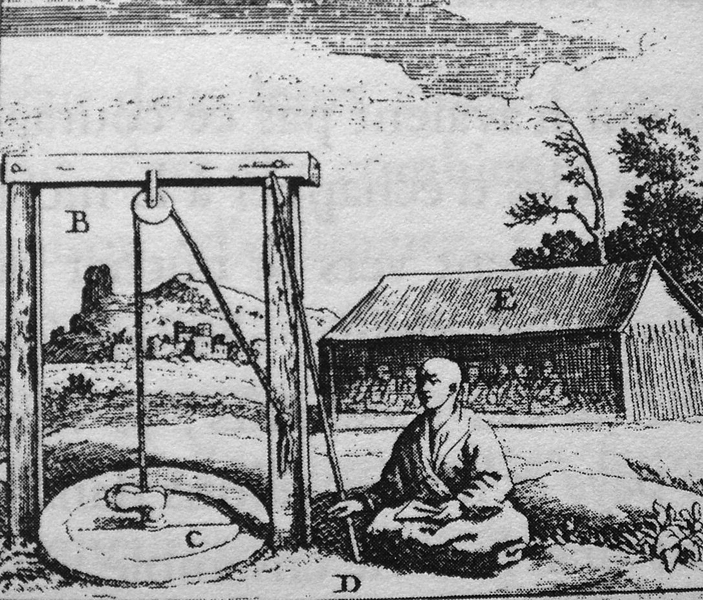
The 'ana-tsurushi' method of inquisitioning and torturing stubborn and resisting Japanese Christian converts,
intensifying in the 1630s and 1640s
Image sources: Facebook and Wikipedia
1639, July 5: The captain-major of two visiting Portuguese ships at Nagasaki is presented with a copy of a decree
which orders the immediate and permanent cessation of all trade between the Portuguese and Japan.
1640, July: A portuguese vessel carrying a specially selected embassy reaches Nagasaki in one last attempt to persuade the shōgun to change his mind.
On August 1, the entire party is arrested and imprisoned.
1640, August 4: 61 of the prisoners are executed on "Martyr's Mount" - 13 native crew members are spared and sent back to the Portuguese colony Macao,
to report what has happened.
Source: C.R. Boxer, 1993, pp. 384-385.
1640:
宗門改役 - SHŪMON ARATAME-YAKU
檀家制度 - DANKA SEIDO
In 1640, in direct consequence of the Shimabara Rebellion, the Tokugawa Bakufu ordered the socalled Shūmon aratame-yaku,
or "officers for examining the religious sects", to be set up.
From this time on, the major sects of Buddhism were made responsible for producing registers of religious affiliation of every Japanese household with one specific Buddhist temple.
The socalled Danka seidō, or "Danka System", in which Japanese households since the Heian Period, 794-1185,
had voluntarily been supporting the temples financially, was now reshaped into a most effective instrument with which the government could monitor the population and
- first of all - suppress and eliminate the Christian faith and its believers, on a mandatory basis.
Read more about the Danka seidō - and the very important socalled tera-uke
寺請, or "temple certificates", issued annually by the temples - on these pages:
WikiPedia: The Danka system
Even though the later komusō fraternity was, seemingly, to some extent officially recognized by the Tokugawa government in January,
1678, in some capacity as a "religious brotherhood", the komusō "temples" did not play any role in administering and partaking professionally
in the Danka System of the Edo Period, at all.
Furthermore, the komusō are not known to have performed formal funeral and ancestor commemoration services,
nor do the komusō temples appear to have had any cemeteries for the common population - nor themselves! - within their precincts. *
This possibly explains, at least in part, why it did not require much more than a few brush strokes for the new Meiji Government - in October, 1871 -
to completely bring an end to the komusō tradition.
* See f.i. Yamaguchi Masayoshi, 2005, p. 187.
1640-1658: INOUE CHIKUGO-no-KAMI MASASHIGE - Chief Inquisitor
The first national sects inspection chief inquisitor is appointed by Tokugawa Iemitsu Shōgun:
Inoue Chikugo-no-Kami Masashige, commonly known but as Inoue Masashige,
井上筑後の守政重, 1585-1661,
served in high-ranking government office, leading the nationwide 'Shūmon aratame-yaku' anti-Christian inquisition organization, from 1640 till 1658,
while most efficiently supervising the nationwide persecution and virtually total elimination of all Christian, Catholic converts
that was most efficiently maintained in Japan till shortly before the end of the Tokugawa Period, in 1859.
Inoue's title appears to have been that of 'shūnin",
就任,
"Official Inspector".
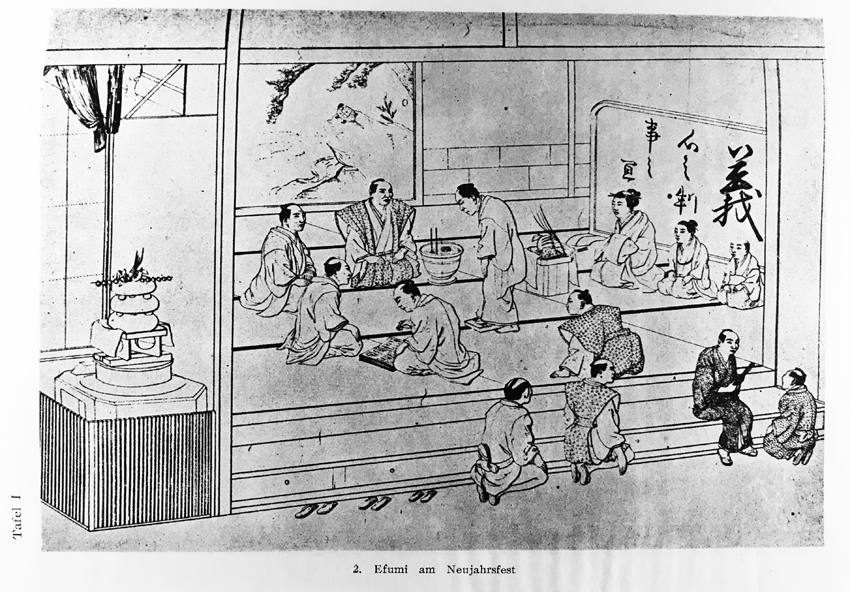
Fumi-e inquisition test. No date, artist unknown.
Source: Voss & Cieslik, 1940, inserted between pages 40 and 41 in the book.
契利斯督記
KIRISHITO-KI - An anti-Christian inquisitor's manual by Inoue Masashige
1640-1658: Inoue Chikugo-no-Kami Masashige writes detailed instructions for the persecutions of Christian converts
during his tenure as first chief religious sects inquisitor appointed by Tokugawa Iemitsu Shōgun.
That "manual for inquisitors" hunting down and exterminating Christian converts was created for internal use only and first compiled under Inoue's successor in office,
Hōjō Awa no Kami Ujinaga,
北条阿波の守氏名(?), no dates, yet.
George Elison, in his monumental work "Deus Destroyed", 1988 (1973), introduces Document VII that focuses on methods of investigation and punishment like this:
"Information on Christianity and its diffusion in Japan is one part of the contents of Kirishito-ki.
But the most significant portions of this manual are those which deal with the methods of the shūmon-aratame yaku.
The greater part of the documents was compiled during the early years of tenure of the second Inquisitor, Hōjō Awano Kami Ujinaga, who succeeded Inoue in 1658.
Inoue departed the office in circumstances that were less than glorious.
His prosecution of the anti-Christian policy had for almost twenty years seemed successful.
But the seed had not really been extirpated: in 1657, 608 Christians were discovered in Ōmura; 411 of these proved unregenerate and were executed.
The incident may well have contributed to Inoue's resignation.
The Kirishito-ki is Inoue's monument, and in the main represents his effort to initiate Hōjō Awa into his duties.
The documents were meant strictly for internal use, and not for propaganda.
As Cieslik and Voss point out [Voss & Cieslik, 1940, see bibliography below, ed.], this unquestionable measure of authenticity greatly increases their value for the historian.
The purpose and procedures of the inquisition are herein revealed in all their grim sobriety and downright terrifying banality.
The meticulous nature of the process is best illustrated in Document VII of the compendium, which deserves quotation in extenso":
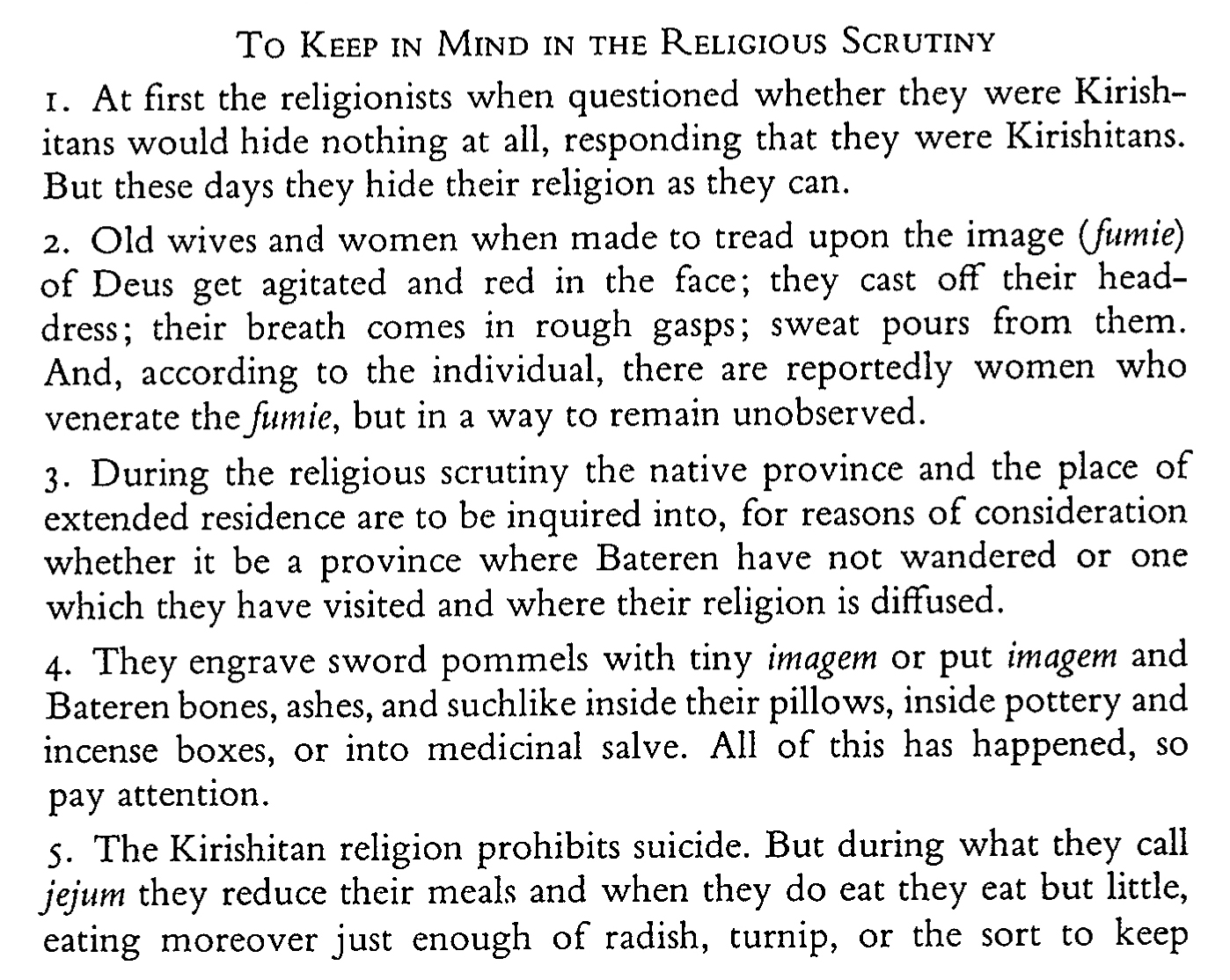
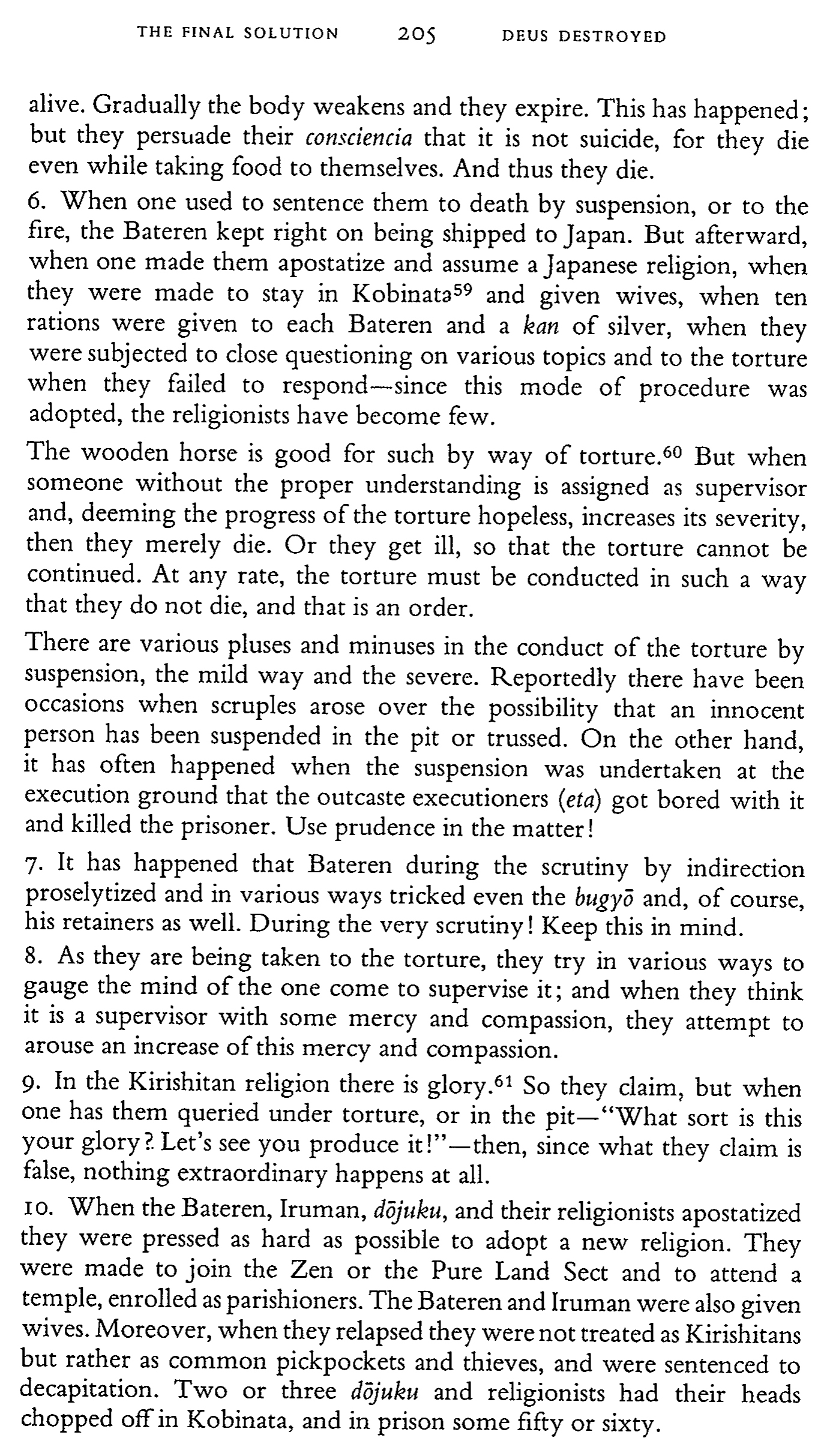
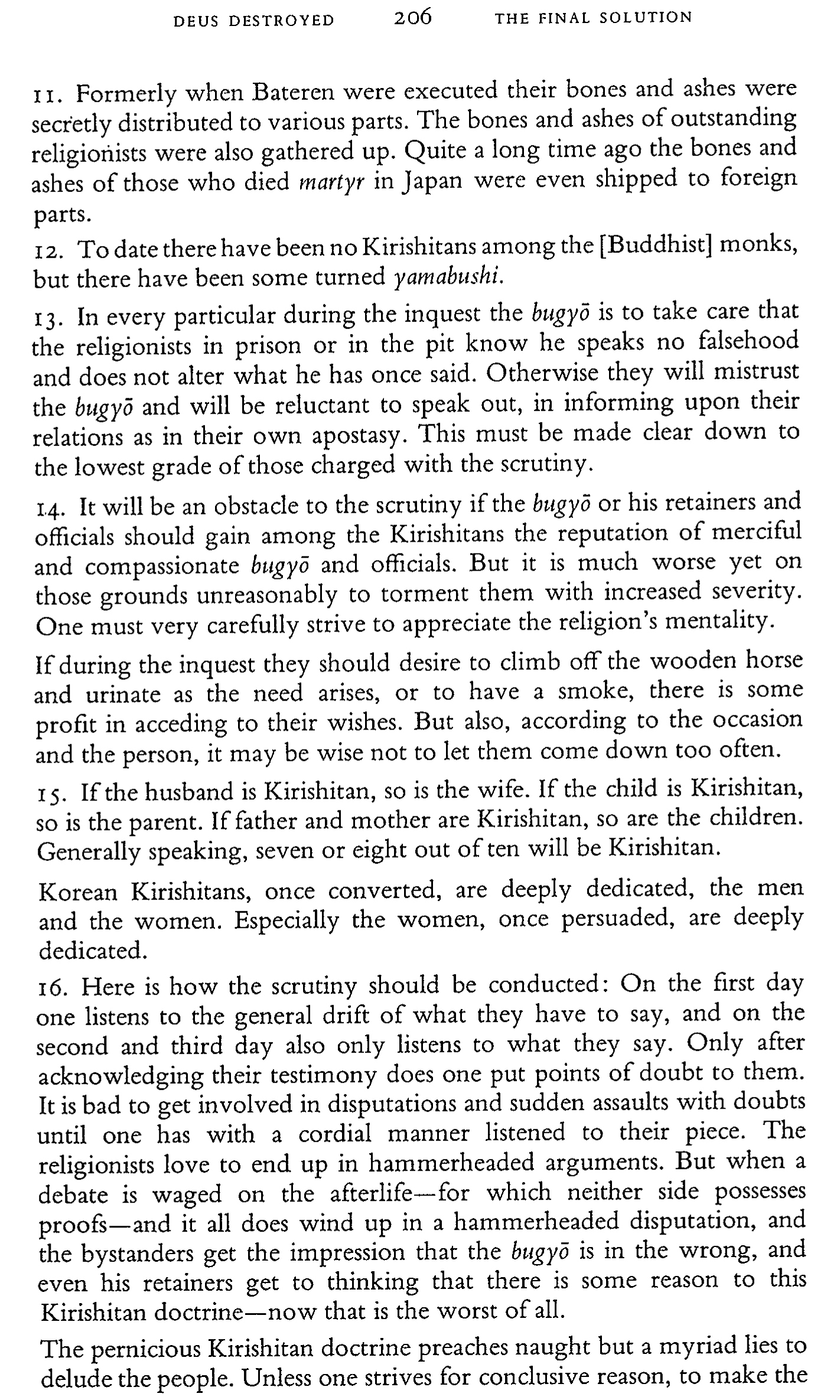
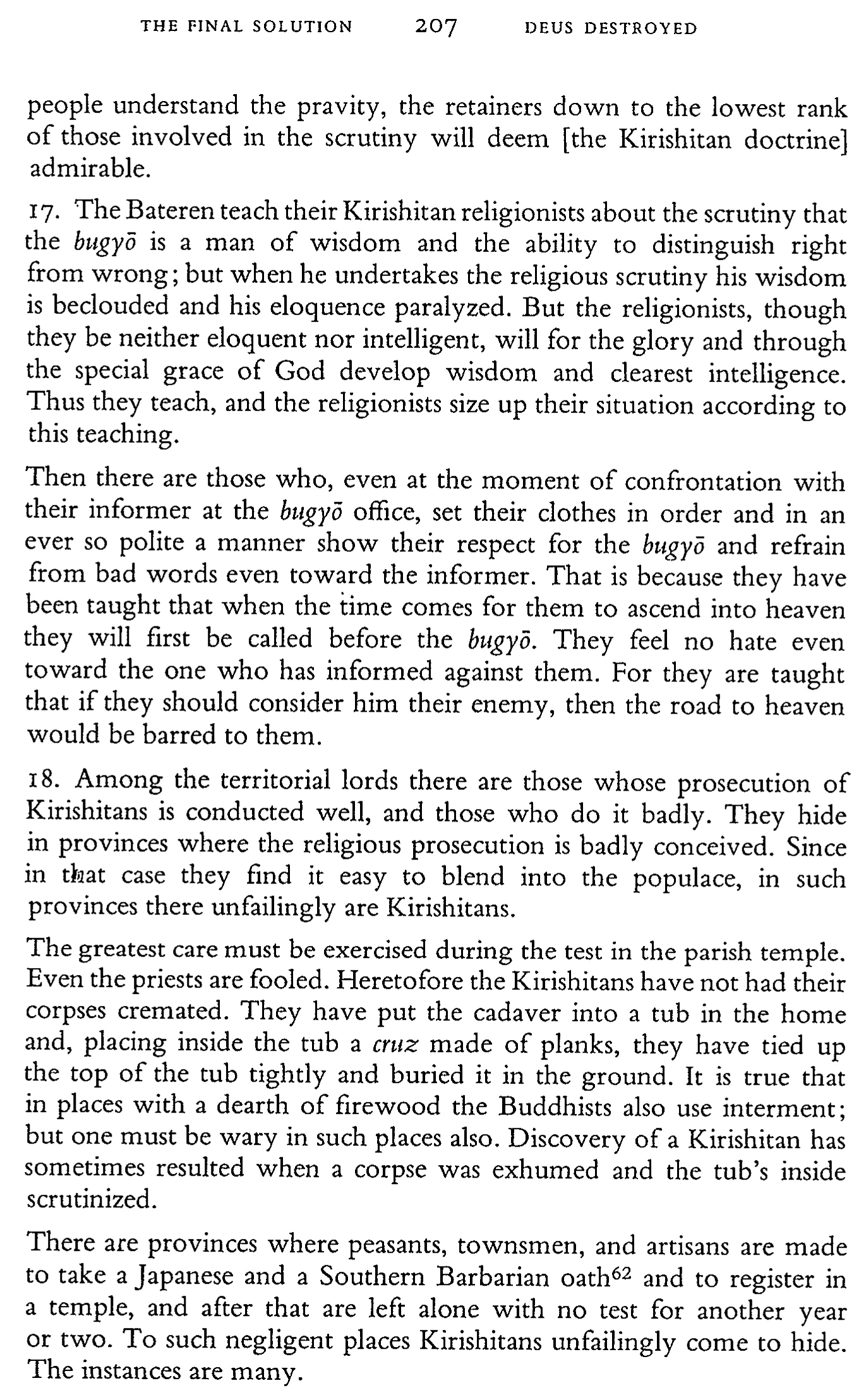
George Elison's translation of Inoue Masashige's Document VII regarding investigation, prosecution, and punishment of Christian converts.
Link to an online edition of the 'Kirishito-ki' c/o the Library of Tokyo University
破鬼理死端/破吉利支丹 - HA KIRISHITAN by Suzuki Shōsan
1642: The former warrior, loyal supporter of Tokugawa Ieyasu, and also devoted Zen buddhist monk and writer, Suzuki Shōsan, 1579-1655,
completes his strongly anti-Christian essay
Ha Kirishitan, "Crush Christianity".
Acc. to George Elison, 1973/1988, p. xi, Ha Kirishitan first published in 1662.
Link to a complete reprint of Ha Kirishitan
Interestingly, Suzuki Shōsan was an outspoken admirer of Fuke Zenji, as evidenced in his 1648 work, Roankyo.
1642: The Jesuit Friar A. Rubino and companions are executed in Nagasaki
1643: Friar Rubino and companions are executed in Nagasaki.
1646: The estate of the once "Grand Councillor" Inoue Masashige, formerly a Christian convert himself, is made into a prison for Christian missionaries.
1648: Suzuki Shōzan, 1579-1655, praises Fuke Zenji in his work Roankyo,
驢鞍橋, "Donkey Saddle Bridge",
translated by Royall Tyler, "Selected Writings", 1977, p. 181:
"I hear P'u-hua was a man of the Buddha's space," said a monk.
Why didn't he bring people to enlightenment?"
The Master replied, "Intense aliveness was his space - not the mode of energy where any enlightening or anything else goes on.
I’m quite sure of that."
Link to Royall Tyler's complete translations, PDF
1651: A 'rōnin' revolt led by Yūi Shōsetsu is put down by the shōgunate.
1657-1658: An attempted revolt involving both 'rōnin' and Christians is discovered and the rioters eliminated.
In the words of George Elison, 1988 (1973):
"608 Christians were discovered in Ōmura; 411 of these proved unregenerate and were executed.
The incident may well have contributed to Inoue's resignation."
Inoue Masashige was the first governmental sects inspection inquisitor, appointed in 1640 by shōgun okugawa Iemitsu.
1661:
WANTED: Believers in the Christian Faith - Earn a Reward !!!
キリシタン
禁制
の
高札 - KIRISHITAN KINSEI no KŌSATSU
"Public Proclamation About the Prohibited Christian Faith"
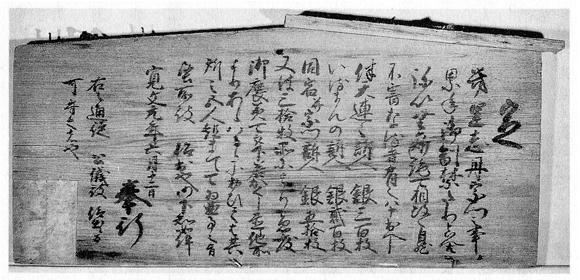
Reward proclamation, public sign board
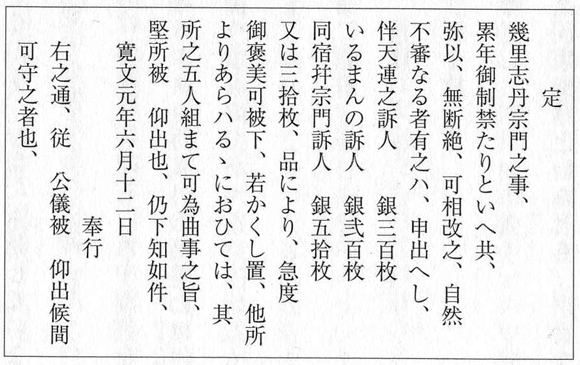
Reward proclamation, wording
1:
伴天連之訴人 (ばてれん之訴人) 銀三百枚
2:
いるまんの訴人 (入満の訴人) 銀弐百枚
3:
同宿弁宗門訴人 銀五拾枚
- - -
寛文元年六月十二日
Japanese text about the promised rewards:
1: "A person who reports a Catholic Father (shall earn) 300 pieces of silver."
2: "A person who reports a non-ordained Christian monk (shall earn) 200 pieces of silver."
3: "A person who reports some one who speaks about the creed in the same place
= a lay believer (shall earn) 50 pieces of silver."
- - -
"Kanbun 1, 6th Month, 12th Day."
Trsl. by Torsten Olafsson, 2018.
Source: Fujii Joji, 2013, p. 69.
See many more examples of such prohibition signboards here, online:
Kinsei no kōsatsu Prohibition Signboards
1661: The Ōbaku Zen sect - an "import" from continental China - is established in Japan, with the temple Manpuku-ji in Uji as its mother temple.
Official recognition is bestowed on this new side branch of the Rinzai Zen sect by prominent both Imperial and Shōgunal support and decrees!
1664: The shōgunate, or bakufu, orders every daimyō to establish in their domain an officer of religious investigation,
i.e. either a magistrate of religion (shūmon bugyō) or magistrate of temples and shrines (jisha bugyō).
1665: Registries of religious affiliation are now being produced on a nationwide scale.
檀家制度 - DANKA SEIDO
THE DANKA SYSTEM of RELIGIOUS INSPECTION
1671: The registry's format is finally standardized. The system of religious inspection and obligatory temple certification
has now become completely consolidated by law and is carried out effectively - and efficiently on a yearly basis, in all of Japan -
with expectable exceptions, of course.
Read more here: Wikipedia: The Danka System
1672:
寺請証文 - TERA-UKE SHŌMON
"Temple Affiliation Certification Document
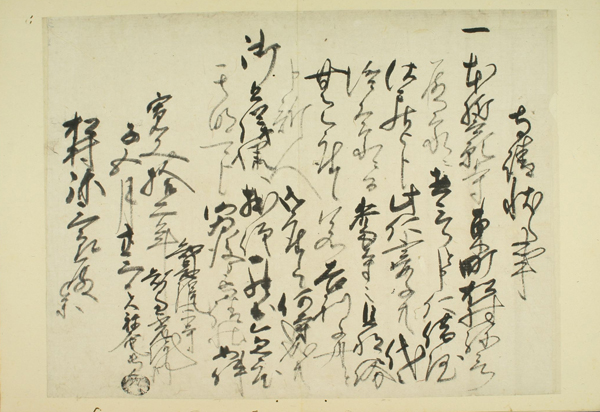
According to the descriptive info presented by the Waseda University Library, this 'tera-uke shōmon' is dated June 8th, 1672 (Kanbun 12, 5th month, 23rd day).
Issued by the Jōdo (Pure Land) Sect temple Chieko-in,
智恵光院, in Central Kyōto, the document confirms that a certain
Matsumura Yasaburo,
智恵光院,
with his entire household is directly affiliated with that temple in the capacity as 'danka',
檀家, i.e. "patron family".
Through such a close relationship monks of the old, well established Buddhist temples were also obliged to inspect all of their respective "patron family households"
on at least an annual basis and reveal any possible hiding Christians there.
Link:
Waseda University 'tera-uke'
1711: WANTED: Believers in the Christian Faith - Report and Earn a Reward !!!
キリシタン
禁制
の
高札 - KIRISHITAN KINSEI no KŌSATSU
"Public Proclamation About the Prohibited Christian Faith"
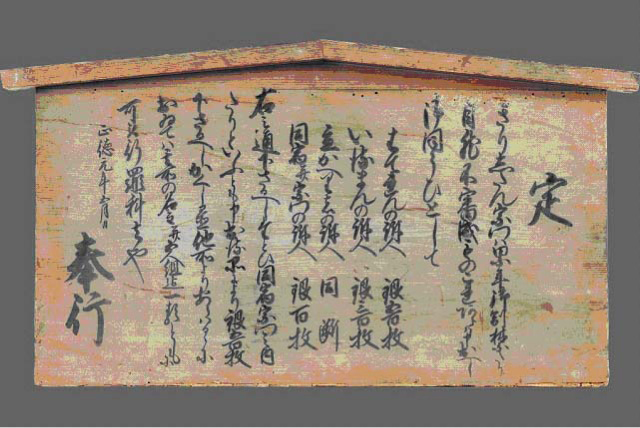
Reward proclamation, public sign board
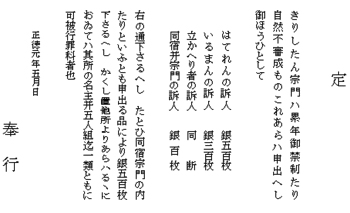
Reward proclamation, wording
1:
ばてれんの訴人 (伴天連之訴人) 銀五百枚
2:
いるまんの訴人 (入満の訴人) 銀三百枚
3:
立かえり者の訴人 同断
4:
同宿弁宗門訴人 銀百枚
Japanese text about the promised rewards:
1: "A person who reports a Catholic Father (shall earn) 500 pieces of silver."
2: "A person who reports a non-ordained Christian monk (shall earn) 300 pieces of silver."
3: "A person who reports a second time/returning lay convert (shall earn) the same (amount)."
4: "A person who reports some one who speaks about the creed in the same place
= a lay believer (shall earn) 100 pieces of silver."
Trsl. by Torsten Olafsson, 2018.
Links:
切支丹禁令
and
踏み絵
RECOMMENDED READINGS:
Masaharu Anesaki: History of Japanese Religion:
with special reference to the social and moral life of the nation
C.E. Tuttle Co., Rutland, Vermont & Tokyo, 1963.
First publ. by Kegan Paul, Trench, Trubner & Co., London, 1930.
Link to online PDF file:
https://archive.org/details/in.ernet.dli.2015.125609/page/n7/mode/2up
Masaharu Anesaki: "Prosecutions of Kirishitans after the Shimabara Insurrection".
In: Monumenta Nipponica, Vol. 1, No. 2, July, 1938, pp. 293-300 (8 pages)
Link to online PDF file:
https://www.jstor.org/stable/2382669?seq=1
Robert Neelly Bellah: Tokugawa Religion: The cultural roots of modern Japan.
Free Press, 1985.
Renata Cabral Bernabé: Religiosity and Underground Life:
Christianity among the Japanese during the Persecution."
In: Bulletin of Portuguese/Japanese Studies, 2nd Series, Volume 5,
December 2022. Link to PDF file:
https://www.academia.edu/94733401/Religiosity_and_Underground_Life_Christianity_among_the_Japanese_during_the_Persecution
Leonard Blussé: "The Grand Inquisitor Inoue Chikugo no Kami Masashige,
Spin Doctor of the Tokugawa Bakufu."
Bulletin of Portuguese - Japanese Studies, núm. 7, december, 2003, pp. 23-43.
Universidade Nova de Lisboa, Lisboa, Portugal.
Link to PDF file: https://www.redalyc.org/pdf/361/36100702.pdf
C.R. Boxer: The Christian Century in Japan, 1549-1650.
Carcarnet Press Limited, Manchester, 1993.
First published in 1951 by The University of
California Press & the Cambridge University Press.
Link to PDF file:
https://ia801603.us.archive.org/9/items/THECHRISTIANCENTURYINJAPAN15491650CRBOXER/THE%20CHRISTIAN%20CENTURY%20IN%20JAPAN%201549-1650%20C%20R%20%20BOXER.pdf
Frank Brinkley, ass. by Kikuchi Dairoku: A History of the Japanese People
from the Earliest Times to the End of the Meiji Era.
The Encyclopædia Britannica Co., New York & London, c. 1915.
Link to PDF file:
https://archive.org/details/historyofjapanes00briniala
Hubert S.J. Cieslik: "The Great Martyrdom in Edo, 1623:
Its Causes, Course, Consequences."
In: Monumenta Nipponica X, 1954, pp. 1-44.
Link to PDF file: https://www.jstor.org/stable/2382790
Jonathan Clements: Christ's Samurai: The True Story of the Shimabara Rebellion.
Published by Robinson, London, 2016.
Michael S.J. Cooper: They Came to Japan. An Anthology of European Reports
on Japan, 1543-1640.
University of California Press, Berkeley, Los Angeles, 1965.
Link to PDF file: https://archive.org/details/theycametojapan0000coop
Jean Crasset: The History of the Church of Japan.
Written originally in French by Monsieur L'Abbe de T.
and now translated into English by N.N. 2 volumes, 2010.
Originally published in 1705-1707.
John Dougill: In Search of Japan's Hidden Christians.
A Story of Suppression, Secrecy and Survival.
Tuttle Publishing, 2012, 2015.
Shūsaku Endō / Endō Shūsaku: Silence.
Original Japanese novel published in 1966.
Peter Owen Publishers, London, 2003, 2007 & 2009.
English translation first published in 1969
by Sophia University Press. Tokyo,
Copyright © by William Johnston, 1969.
Movie by Martin Scorsése published in 2016.
Edward Hagemann: "The Persecution of the Christians in Japan
in the Middle of the Seventeenth Century."
Publ. in Pacific Historical Review
Vol. 11, No. 2, June, 1942, pp. 151-160 (10 pages)
Made available byy: University of California Press
Link to online PDF file: https://www.jstor.org/stable/3633765
Nam-lin Hur: "Anti-Christianity and Funerary Buddhism in Tokugawa Japan."
PDF-file, The University of British Columbia, January 2005.
Download link: https://www.researchgate.net/publication/279504647_Anti-Christianity_and_Funerary_Buddhism_in_Tokugawa_Japan
Nam-lin Hur: Death and Social Order in Tokugawa Japan:
Buddhism, Anti-Christianity, and the Danka System.
Harvard East Asian Monographs 282, Harvard University Asia
Center, Cambridge, Mass. & London, 2007, 550 pages.
Joseph Jennes: History of the Catholic Church in Japan,
From its Beginnings to the Early Meiji Era (1549-1873).
A Short Handbook. 1973.
Fujii Joji: Edo jidai no o-fure.
"Public Proclamations in Edo Period Japan."
Yamakawa Shuppansha, Tokyo, 2013.
Tanabe Hisao: Nihon no ongaku.
Bunka Kenkyūsha, 1947.
Tanabe Hisao: Nihon no ongaku.
Bunka Kenkyūsha, 1954.
Stephen Turnbull: The Kakure Kirishitan of Japan: A Study of their Development,
Beliefs and Rituals to the Present Day.
Routledge, New York, 2013 (1998).
Gustav Voss & Hubert Cieslik (trsls.): Kirishito-ki und Sayō-yoroku:
Japanische Dokumente zur Missionsgeschichte
des 17. Jahrhunderts (English).
Sophia University, Tokyo, 1940, 229 pages.
|


|
